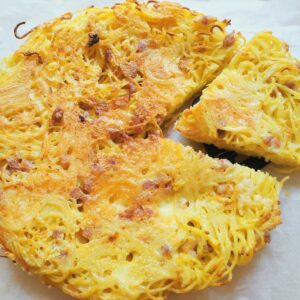This traditional Neapolitan spaghetti frittata recipe is a fabulous was to use up leftover spaghetti. You can eat this frittata hot or cold and serve it as part of a buffet. potluck or with an aperitif. This classic version includes eggs, two kinds of cheese (parmigiano and scamorza) and pancetta.
History
Spaghetti frittata, also known as frittata di maccheroni, is an easy to make family favorite in Naples and throughout Campania. This recipe was created to make use of leftover pasta and prevent waste.
In fact, there are many Italian recipes invented as a way to use up stale foods or leftovers. A lot of these recipes originated in what Italians call ‘la cucina povera’ meaning the poor or peasant kitchen.
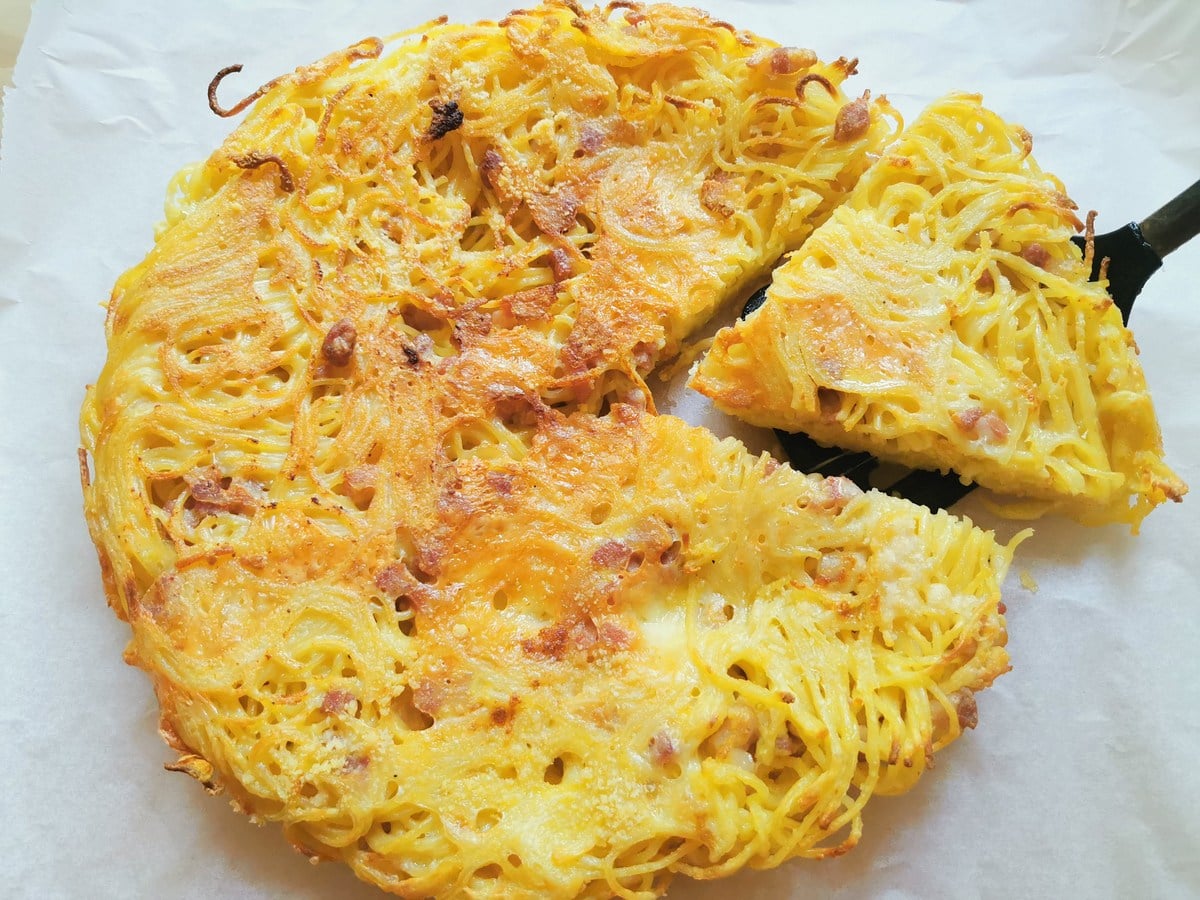

Other versions of pasta frittata.
Although this Neapolitan spaghetti frittata is probably the most well-known, you can find other versions of pasta frittata throughout Italy. But, it’s most popular in the Southern regions.
I have already published a vermicelli frittata recipe from Basilicata which has anchovies, garlic and peperoncino (red chilli pepper) but no meat or cheese. It’s similar in flavor to spaghetti aglio e olio.


The majority of Italian pasta frittata recipes are made with long pasta such as spaghetti, linguine, vermicelli, bucatini etc. However, you can make this recipe with short pasta tubes such as penne, rigatoni, ziti etc.
It’s also popular to include tomato sauce in a spaghetti frittata. This means you are using up not only your leftover spaghetti but the sauce too.
What’s the difference between a frittata and an omelet?
The main differences between an Italian frittata and a French omelet are that for a frittata, Italians mix the ingredients into the eggs before cooking. The French place the omelet filling onto the eggs after they have already started cooking in the pan.
Also, a frittata is traditionally circular in shape and thicker than an omelet. It generally takes longer to cook as well. Of course, French omelets don’t ever include pasta! Frittatas do.


Ingredients, substitutions and tips for this spaghetti frittata.
The pasta: Many types of long and short pasta work well in a frittata. I used spaghetti, but you can use the pasta of your choice. Of course, you don’t need to wait to have leftover spaghetti to make this recipe. Many Italians cook pasta specifically to make a frittata!
Expert tip: Next time you make spaghetti, cook extra so you can make frittata the next day!
The eggs: Apart from the pasta, eggs are the main ingredient in this spaghetti frittata. I prefer to use large free-range eggs for their taste and quality. Calculate one egg per person plus one extra!
The cheese: A typical spaghetti frittata from Naples contains grated Parmigiano or Grana and scamorza. The latter is a Southern Italian cow’s milk cheese that’s made in a similar way to mozzarella. However, unlike mozzarella scamorza is tied and hung for 1-2 weeks before it’s ready to eat. The flavor is saltier and the texture firmer than mozzarella.
Expert tip: If you can’t find scamorza, use provolone, or a low-moisture mozzarella.
The meat: The recipe I followed for this leftover spaghetti frittata called for pancetta, but Italians also use salami, soppressata or mortadella. The pancetta can be cooked beforehand or added as is to the frittata ingredients. I prefer to fry it a little, but Italian pancetta can be eaten raw, so you don’t need to fry it first.
Expert tip: I prefer to fry the pancetta a little, but Italian pancetta can be eaten raw, so you don’t need to fry it first.
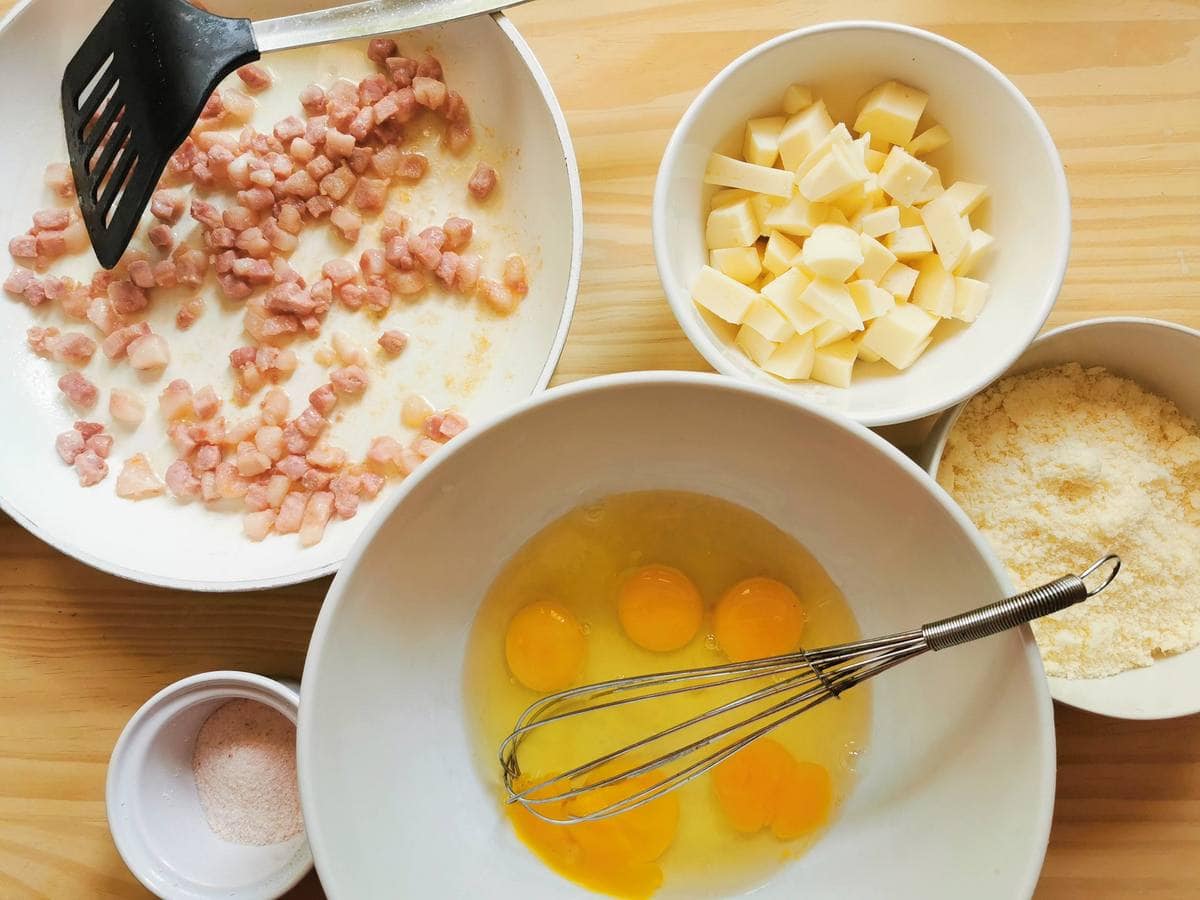

Other ingredients.
This spaghetti frittata is a very simple recipe. Apart from the eggs, pasta, cheese and pancetta, all you need is some salt, pepper and chopped fresh parsley. Of course, you could also add other veggies such as mushrooms or spinach and leave out the meat for a meatless version.
But, to make this recipe vegetarian you will need to use vegetarian cheese. Some types of scamorza are vegetarian but Italian Parmigiano and Grana are not. They are made with animal rennet!
Step be step instructions.
First of all, if using uncooked spaghetti, cook the pasta al dente in plenty of water and salt. Then drain it well and let it cool. If using leftover spaghetti that’s been kept in the fridge, bring it to room temp first.
In the meantime, fry the pancetta in a little olive oil until it starts to brown, break the eggs into a large bowl and beat them and cut the scamorza cheese into small pieces.
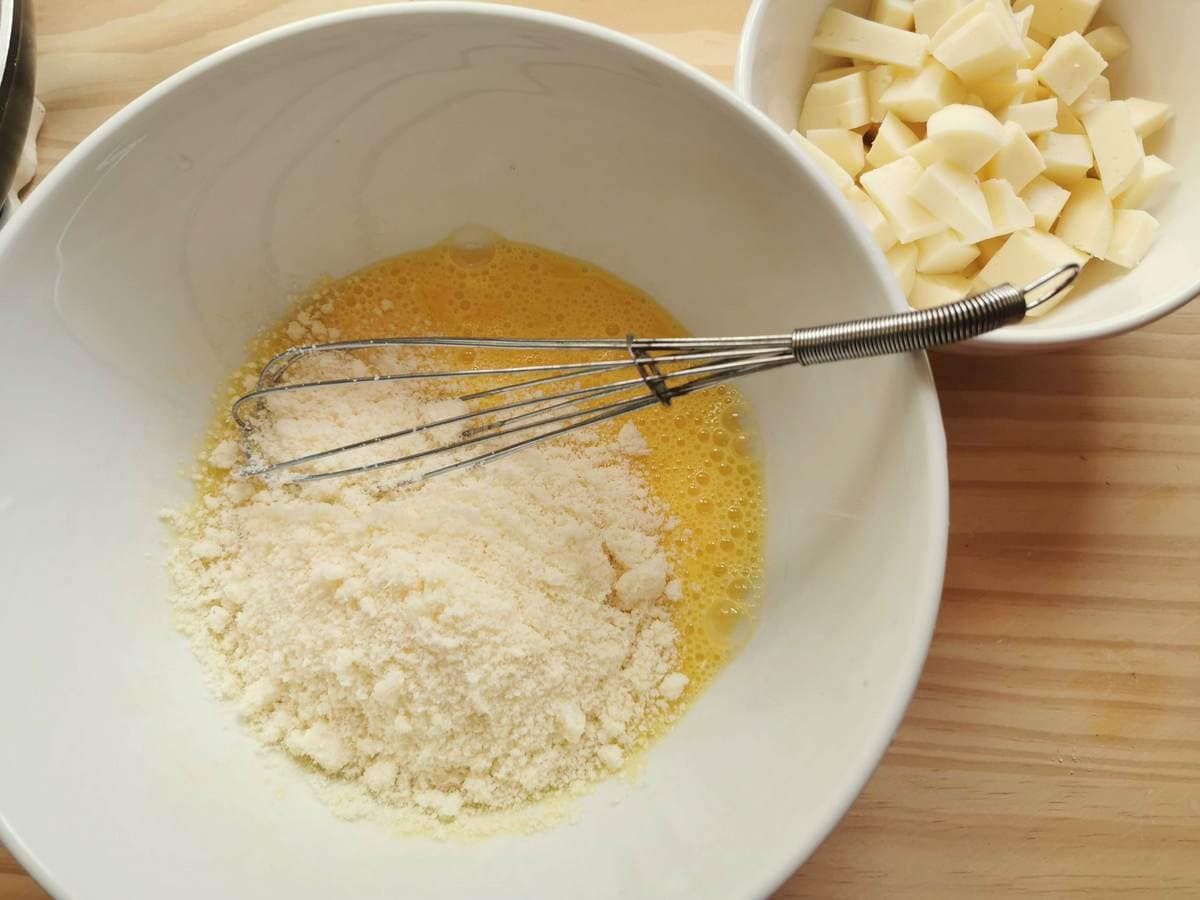

Add both types of cheese to the eggs and mix together. Then, add the pancetta, salt and pepper and the butter cut into small pieces to the eggs as well and mix again.
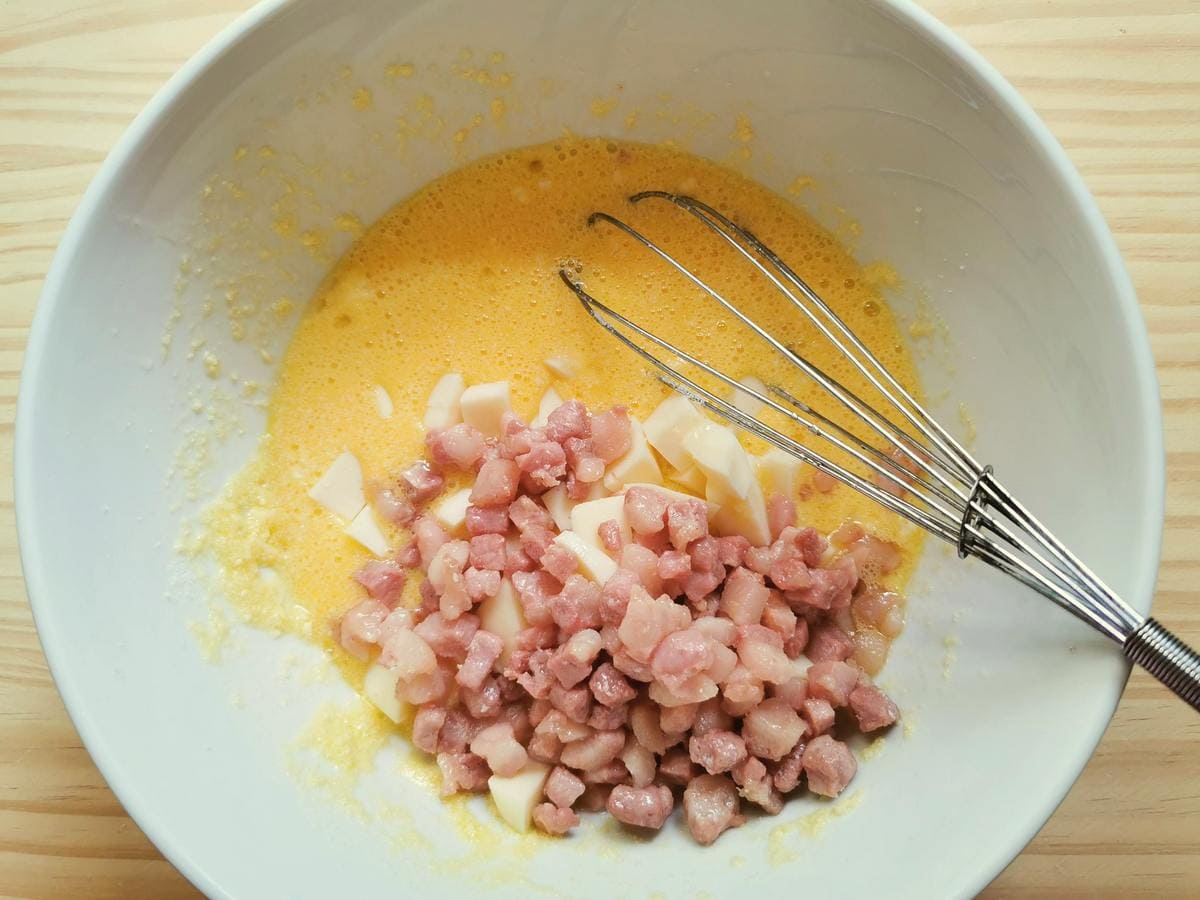

Finally, put the cooked spaghetti into the bowl with the other ingredients and mix and toss until the spaghetti is well incorporated with the eggs, cheese and pancetta.


Heat a little olive oil in a non-stick deep skillet or frying pan and then pour the frittata ingredients into the pan.


When a fairly compact crust has formed on the bottom (you can see from the edges and by shaking the pan), turn your spaghetti frittata upside down onto a serving plate:
Finally, add a little more olive oil to the pan and once it’s hot, slide the frittata back into the pan with the uncooked side underneath. Cook for a few more minutes, until you have a nice golden crust on the other side too.


Allow your frittata to cool slightly before cutting it into serving slices. It’s delicious warm or once cooled. Serve it with a salad for lunch, take it on picnics or potlucks, or eat it for breakfast!
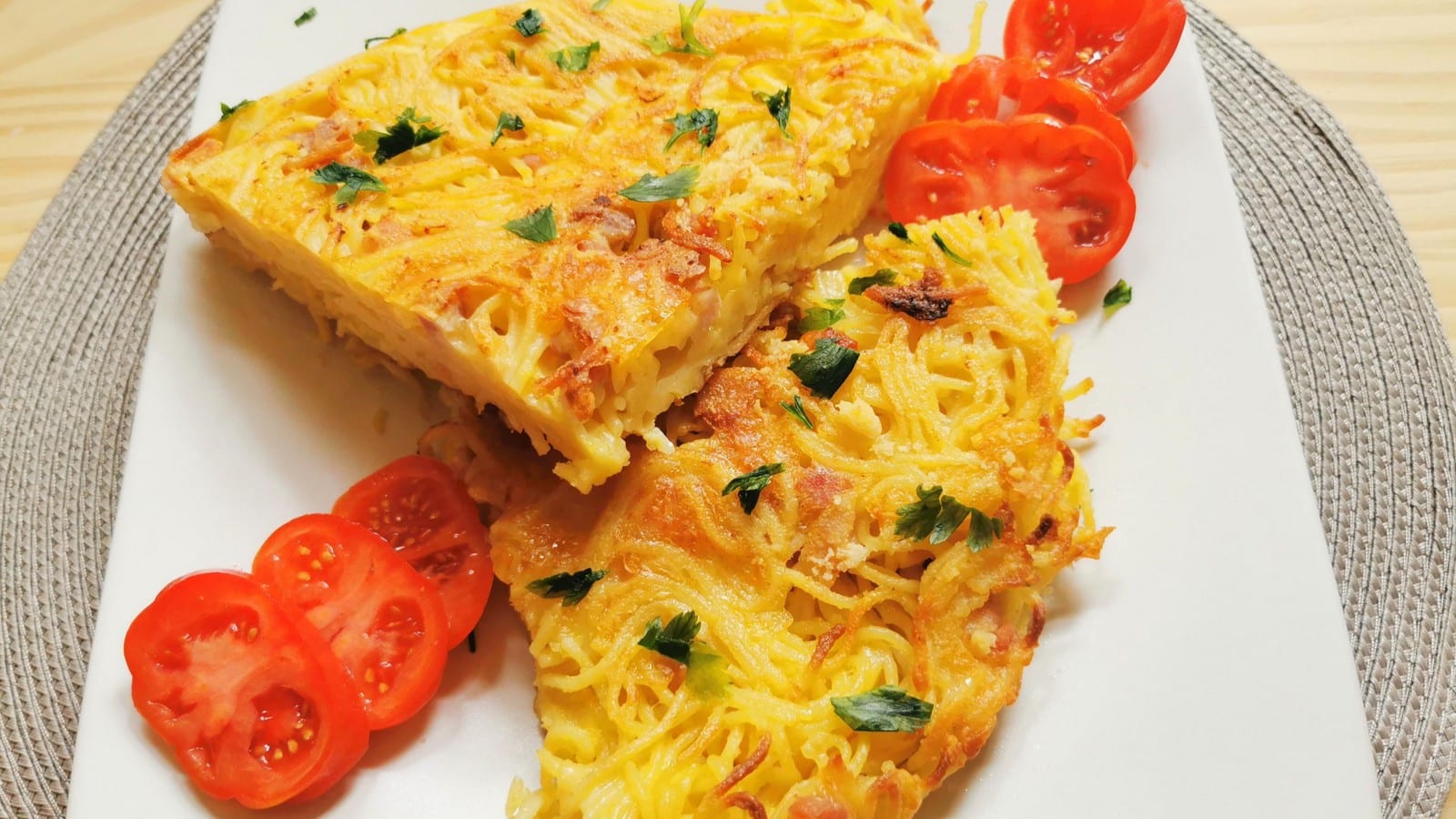

What to do with leftovers.
Leftover spaghetti frittata can be kept sealed in the fridge for up to 2 days. To reheat it, use the microwave. You can also bring it to room temperature and eat it cold.
Let me know what you think.
If you make this Neapolitan spaghetti frittata recipe, I’d love to hear how it turns out and if you liked it. So, please leave a comment here on the blog or on The Pasta Project Facebook page.
Looking forward to hearing from you!
Buon appetito!
Pin for later.


Other pasta recipes for snacks.
- Fried rye flour ravioli
- Baked ravioli (piconi ascolani) from Marche
- Pasta arancini
Reader Interactions

